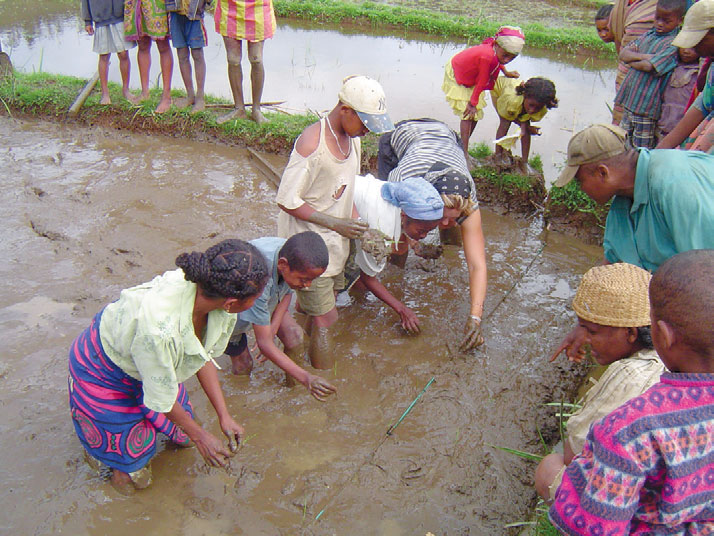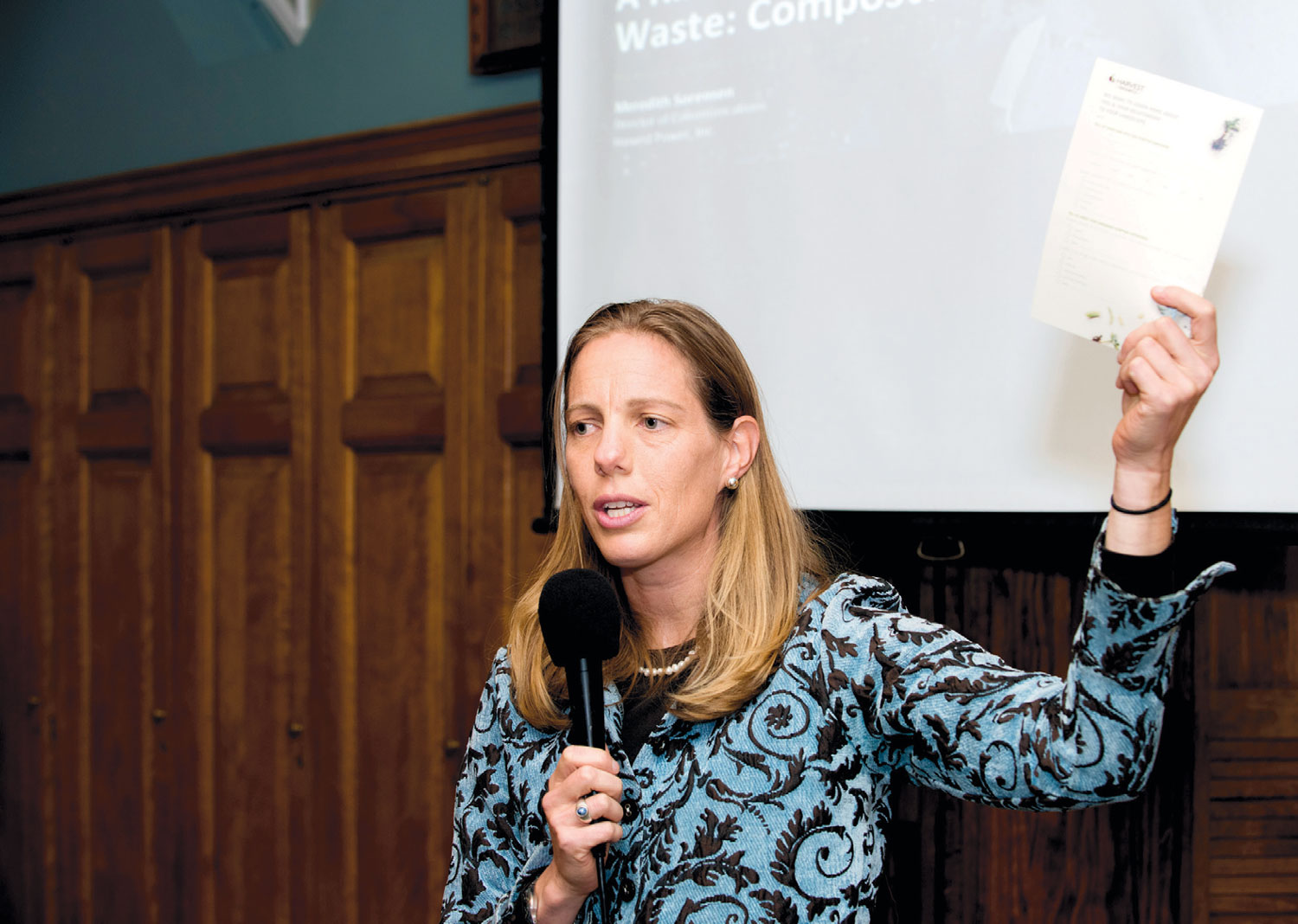The Compost Guru
One woman’s journey to save the planet, one acre at a time
Meredith Sorensen has long known the value of trash. As a child, she would smuggle banana peels home from a friend’s house and bury the treasure in the compost pile of her family’s home in Rumson. The peels would quickly lose their rubbery exterior, like schoolchildren shucking off their yellow rain slickers in a warm classroom, and the blackened remains would merge with the rest of the mush in the pile. Soon, there’d be compost, a good, nutritious meal for the garden. Secret buried treasure, made from nothing.
Nowadays, any gardener worth her sprouts knows the benefits of soil amendments, and many backyards feature robust compost piles. But a few decades ago, when the use of chemical fertilizers was the norm, this was radical behavior for a suburban family, even in leafy Rumson. Sorensen’s parents, Leigh and King Sorensen, were avid flower and vegetable gardeners, ahead of their time. And not at all squeamish.
“We celebrated each grub and worm: Look at that one, so juicy!” their daughter recalls. “We always composted. That’s just the way we were.”
Kids like to dig in the dirt. Peek under rocks. Twirl dandelion stems and wave sticks like magic wands. Sorensen never outgrew the tactile delight that comes with playing with whatever’s on the ground.
In fact, she’s made a career of it.
Sorensen is president of Solid Strategies, a communications firm in Portland, OR, that specializes in recycling and waste management needs. She is also the communications director for Harvest, a Massachusetts-based company involved in a number of green endeavors, including organic waste processing and the production and sale of natural mulch, soil and compost.
“Compost supports life in and of itself,” Sorensen says. “It is chock-full of bacteria. There are millions of bacteria inside the space of a teaspoon of soil. Composting is about controlling local resources and putting local resources at your fingertips, literally at your fingertips. In this era of global warming, it’s something you can control.”
Melissa Almendinger, who runs the community garden at Duke Farms in Hillsborough, is also a strong proponent of composting, for reasons bigger than the hefty tomatoes that benefit from soil enrichment.
“Yes, you’re going to be improving your soil by composting,” Almendinger says. “But the main thing is, you’re reducing waste. The idea is to take it out of the waste stream.”
Sorensen aims to accomplish that goal by making the idea of composting irresistible. Her work involves storytelling as much as it does science. Sorensen travels often for business, researching how various regions handle organic waste. She also gives presentations on composting, as she did in October, returning home to speak to members of the Rumson Garden Club at the Rumson Country Club.
During that appearance, Sorensen was preaching to the choir. Her audience of gardeners nodded knowingly as Sorensen outlined the benefits of compost to soil structure and how backyard and commercial composting can divert organic waste from landfills. But she also pushed a few buttons, wondering aloud whether Rumsonites—or even the country club itself—leave grass clippings on their velvety lawns, rather than bagging them and putting them out at the curb. And Sorensen spoke in stark terms about the importance of composting on a global scale.
“Composting can mean the difference between life and death,” she says.
Sorensen knows of what she speaks. Not only does her work with Harvest make her keenly aware of the impact of solid waste on the environmental health of the United States, but she also has firsthand experience promoting compost to an audience much tougher than the Rumson Garden Club: the subsistence rice farmers of Madagascar.

“Composting can mean the difference
between life and death.”
—Meredith Sorensen

PHOTOGRAPHS: COURTESY OF MEREDITH SORENSEN
In 2004, Sorensen embarked on a 1600-mile hike through Madagascar. She had served in the Peace Corps in Madagascar and the Ivory Coast from 2002 to 2004, and was familiar with Madagascar’s reliance on slash-and-burn agriculture, an ancient technique in which farmers clear forests for farm land and burn the remaining vegetation, creating a layer of ash that temporarily enriches the soil. After a few growing seasons, the nutrients in the soil are depleted, and farmers must move on and, in a destructive cycle, burn another parcel of land.
While in the Peace Corps, Sorensen lived in a village on the edge of the forest corridor and led demonstrations on composting, aided by her conversational fluency in Malagasy and a picture book about compost.
“After a while, they jokingly called me Mrs. Compost and gently rolled their eyes when I brought out the book,” Sorensen says. But she wasn’t all talk.
She built compost piles, enlisting help from children of the village. And she conducted compost experiments, sprinkling compost on half a field and leaving the other half to grow as the farmers intended.
“Then three months later, we’d go back to the field, and the difference was striking,” Sorensen says. “The plants that had had compost were higher, lusher green and, most importantly, loaded with rice panicles. Even I was shocked at the difference. They then said, ‘Can we take a look at that cartoon book again?’“
During her journey, Sorensen conducted 74 presentations to 12,600 farmers on a sustainable method of agriculture called the System of Rice Intensification (SRI) technique. SRI incorporates composting to improve soil fertility and food security.
“By improving the soil, people have more food and could sell the extra,” Sorensen says. “They also didn’t have to go farther and slash-and-burn more land to create more fields. So, it made for a shorter commute time, to translate to New Jersey language.”
Making composting a universal habit is not easy in the United States, and it’s not easy in Madagascar. Slash-and-burn farming techniques are still the default approach in Madagascar. But some farmers do practice alternative methods. A year after her presentation to a village in Madagascar, Sorensen returned, unannounced, and witnessed one of the families she had worked with, carefully applying compost to crops.
“I know I made a difference to at least one family,” she says.
Slash-and-burn isn’t the problem in the United States. In our land of plenty, food waste clogs landfills and strains the environment. Large-scale, commercial composting would help to ease that burden, but that is easier said than done.
“It seems like a key to unlocking broader systems of collection and composting is public-private partnerships,” Sorensen says. “Everything needs to align: government setting the policy, residents and businesses sorting at the source, getting permits, having capital to build and operate facilities, operating the facility successfully, and marketing the compost back around for use on parks, fields and landscapes.”
Small steps by individuals, whether a home gardener in New Jersey or a rice farmer in Madagascar, can nudge a society closer to sustainability.
“It’s hard to gauge the broader impact of my work, and it’s certainly disheartening to hear that slash-and-burn has continued,” she says. “But I tell you, turning the corner on the path and seeing that family adding compost to their fields—that keeps a small flame of hope alive for me.”





